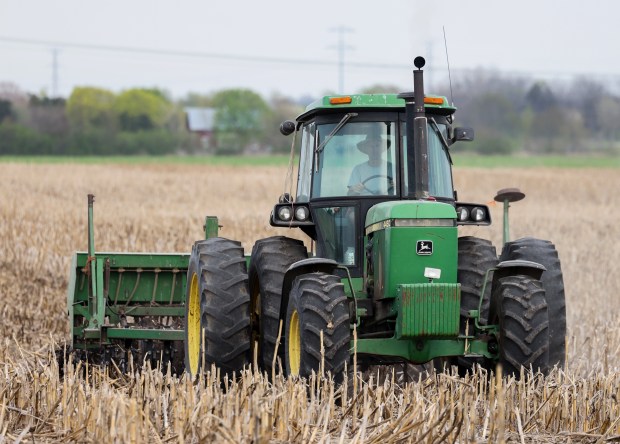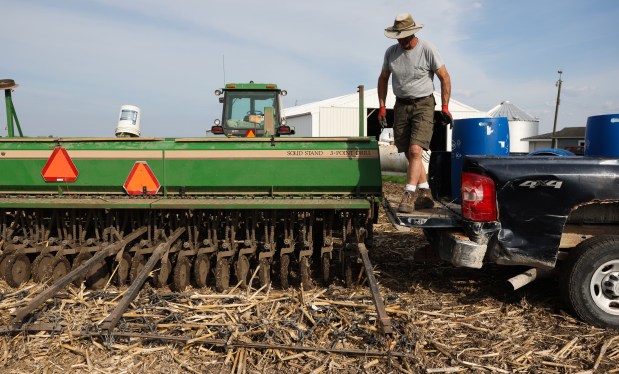As April showers cleared over the village of Manhattan this week, John Kiefner got to work planting soybeans.
He is not alone. Illinois farmers expect to plant about 10.5 million acres of soybeans this year, an area equivalent to nearly 30% of the state’s entire land mass. China is by far the largest customer for soybean exports: Illinois exported about $2.4 billion worth of soybeans last year, $805 million of which went to China, according to data from the U.S. Department of Agriculture’s economic research service.
But with the country now in the midst of a trade war with China — after President Donald Trump enacted sweeping 145% tariffs on Chinese imports and China responded with 125% retaliatory tariffs in turn — that relationship is at risk.
During Trump’s first-term trade war with China, the country turned increasingly toward other nations, particularly Brazil, for soybean imports. Now, agricultural experts and soybean industry insiders are worried the market could get worse for soybean farmers stateside.
“Last time, we lost about 20% market share,” said Todd Main, director of market development for the Illinois Soybean Association. “The federal government put some financing programs to help cover the revenue stream for that first year that farmers lost. But that lasted one year, and the 20% market share never came back.”
“I think it’s going to be a disaster for Illinois soybean growers,” said William Ridley, an agricultural economist at the University of Illinois.
A cheap form of protein, soybeans are used to make tofu and soy milk. But the soybean’s value as an export is primarily derived from its use in animal feed. China relies on soybean imports to help sustain its massive livestock industry, Ridley said.
In the fall, Kiefner — who has farmed Illinois soybeans for more than 40 years — will harvest his crop. He’ll deliver his bushels to a grain terminal on the Illinois River, about 60 miles southwest of Chicago, after which, he can assume, they will make their way downriver all the way to New Orleans, where they’ll be shipped overseas.
He never knows for sure where the beans end up.
Kiefner, for one, isn’t too worried about his own prospects. He gets about one-third of his income from soybeans, meaning he’s less reliant on the crop than some other farmers. He’s also adjusted the ratio of the crops he plants to weigh more heavily toward crops that aren’t exported.
“I am planting less corn and soybeans and as many acres of oats and wheat as I can,” he said.
He also said he thinks it’s possible that Trump’s trade tactics might work.
“It’s no secret that rural America helped President Trump win the presidency,” said Kiefner, who said he voted for Trump. “I think everybody wants the same thing: a strong American economy. It’s just everybody thinks there’s different ways to do it.”
Kiefner is cautiously optimistic that things will turn out OK for farmers.
“I guess you could say I have trust in what he’s doing, or faith in what he’s doing, even though I can’t even begin to comprehend what his end game is,” Kiefner said.

During the last trade war, farm bankruptcies increased, the agricultural economist Ridley said. That was despite billions in federal aid the administration allocated for farmers affected by tariffs.
Farmers told the Tribune they are optimistic more aid would come, though they said they’d prefer to sell their soybeans for profit rather than get bailed out by the government.
White House spokesperson Anna Kelly did not directly answer a question about whether or not farmers would get additional tariff-specific federal aid this time around.
“The USA will protect our farmers, and this President cares deeply about strengthening America’s agriculture industry,” Kelly said in a statement. “After four years of regulatory uncertainty, trade imbalances, and radical environmental policies under Joe Biden, President Trump is already delivering relief by working to end unfair trading practices, unleashing American energy, cutting ten regulations for every new regulation.”
The Department of Agriculture, Kelly said, is “evaluating new ways to ensure (farmers) have the resources they need to feed the world.”
And on Tuesday, U.S. Treasury Secretary Scott Bessent said he expected “de-escalation” in the trade war, which he described as unsustainable. But Trump himself avoided saying if he thought the situation is as unsustainable as Bessent suggested, The Associated Press reported.
On Thursday, China denied it was in negotiations with the Trump administration over tariffs, describing the idea of making progress on the issue as like “trying to catch the wind,” the AP reported.
For its part, Illinois Farm Bureau President Brian Duncan said the organization is holding “regular conversations” with members of the Trump administration to advocate for fair trade.
“Illinois farmers’ products — from corn, soybeans, ethanol, beef, pork and more — rely on access to foreign markets and will undoubtedly be impacted by tariffs through either increased prices or decreased market access,” Duncan said in a statement.
On his farm in Somonauk, about 70 miles southwest of Chicago, farmer Mark Tuttle said his plans for this year haven’t changed. He’ll plant about 60% corn and 40% soybeans.
Tuttle, who is also a district director for the farm bureau, said he is willing to deal with the tariffs for now, but doesn’t think farmers could handle their effects over a long period.
Farmers tend to be optimistic types, Tuttle said, and they wouldn’t be working in the field if they weren’t.
“We all get spring fever,” he said. “We’ll get through it. We always have. But we don’t need the government getting too involved in telling us what we can or we cannot sell.”



